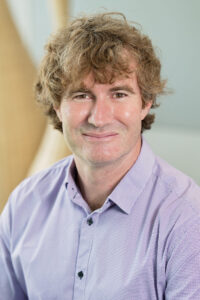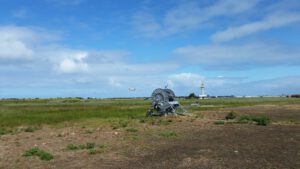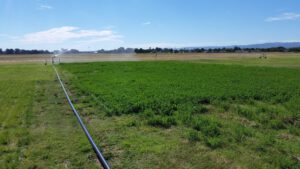Today, the project is in testing and is focused on applying anywhere from 0.47 to 0.59 inch of recycled water up to 3 evenings per week on a 10-acre patch of alfalfa south of the airport. While he had a strong inkling that the irrigation and the alfalfa patch would benefit the airport, he had no idea just how much the project would benefit SA Water, the airport, and the airlines, as well as the general public. Not only will it help the airport look nicer when the irrigation area is expanded, but the experiment also has shown that proper irrigation can reduce average ambient temperatures by around 5.5 degrees Fahrenheit.
In an interview with Municipal Water Leader’s writer, Tyler Young, Mr. Ingleton discusses his idea for urban greening, its social benefits, and other innovative ideas for the future.
 Tyler Young: Please tell our readers about your background in the water industry and about your time in South Australia with SA Water.
Tyler Young: Please tell our readers about your background in the water industry and about your time in South Australia with SA Water.
Greg Ingleton: I grew up in Sydney, Australia, wanting to be a farmer. After 15 years, I realized all I was doing was making the farmers rich, so I decided one day that I was going to go to university to study environmental science. An older gentleman at a local hardware store in Byron Bay, New South Wales, told me, “You know, son, water is where it is at. You have got to get involved in water.” So I did just that.
As part of my environmental science degree, I studied recycled water. Once I finished my degree, I looked at a map of Australia to find a dry capital city in Australia; Adelaide was it. It is located close to the coast and had a good cost of living, so I moved there 15 years ago without a job and without knowing anybody. I was able to find a home and enter into a graduate program at SA Water.
For the last 15 years, I have been working in an industry that was historically dominated by male engineers. That is changing somewhat these days. During my time, I’ve noticed that engineers think differently than environmental scientists like me. One is definitely not better than the other, but each is uniquely different. As an environmental scientist, I look for ways that we can do things without building infrastructure. I have had a lot of opportunities to look at different aspects of the water cycle and different aspects of water quality. My main focus now is looking at making the most of our recycled water and future opportunities with storm water and providing the best benefit to our customers.
Tyler Young: What is the history of SA Water?
Greg Ingleton: SA Water is a large organization, founded as a government corporation in 1856. We provide water and wastewater services to around 1.6 million customers, which is around 95 percent of the population of South Australia. SA Water has been leading the way in Australia on recycling water for the past three decades, and we’re now recycling around 30 percent of our wastewater every year. Although a majority of the population of South Australia resides in Adelaide, our rural areas contain many farms that rely on groundwater to irrigate. That being said, as a state government organization, what money we make is contributed to the government’s budget for schools or hospitals to benefit the South Australian community.
Looking at our natural resources, we have one big river, the River Murray, which runs through the state. It flows in from New South Wales and Victoria. A certain volume of our water for the city comes from rainfall and runoff into our reservoirs located in the hills around the city and water we take from the River Murray; just 2 percent comes from the Adelaide Desalination Plant, which we keep running in the background, ready to step up and supply the city if drought conditions return in future. The majority of the state’s regional towns are serviced with groundwater from natural aquifers.
South Australia is a dry state. In fact, it is the driest state in the driest inhabited continent on earth. Our rainfall in the city is about 19.5 inches per year, while the rainfall in the hills goes up to 31.5 to 35.5 inches per year in some areas. Beyond that, some places only get 8 inches and others as little as .60 inch of water per year.
Tyler Young: How did you make your idea of localized irrigation at airports into the success it is today?
Greg Ingleton: One day when flying into Adelaide airport, I had a vision that stemmed from my research on urban heat islands. At that time, the airport was pursuing efforts to become more sustainable. When it came time to sell them on my idea, I thought about all the benefits for them and for SA Water. From SA Water’s perspective, we had a recycled water system that ran by the airport. If we did not use the water on the land, we would have to turn it out to sea, which we have to pay a license fee to do. By putting the water on the land, we would actually save money for SA Water and potentially for Adelaide Airport. That was kind of the base case for the project and the hypothesis we wanted test with the airport.

After that point, I started to pursue a test trial to work out any problems. These trials always have to be reversible, so if they do not work I can just collect the equipment and move on to another idea. With this one, the biggest issue we identified was birds. Birds are automatically attracted to water, and since birds and airplanes do not mix, we wanted to make sure we did not increase the number of birds around the airport. The trial gave everyone a lot of confidence. The interesting thing with all these experiments is that it’s not until the experiment is started and data are gathered that all the unforeseen benefits are identified.
To begin with, I did not think about increased aircraft performance when I started the project. It turns out that the temperature decrease caused by irrigation leads to a decrease in fuel consumption during takeoff. Also, one of the biggest savings is from airlines not having to reduce payload as much. On hot days, airlines have to adjust their payload significantly. Now, the temperature difference that will be associated with this project once it is fully expanded across the airport could mean the difference between a flight being profitable or running at a loss. The ability to cool the airport by around 5 degrees Fahrenheit means the difference in hundreds of pounds of freight that can stay on a plane because of that cooler air. It turns out to be a huge difference to the airline. When I started to present some of the results around Adelaide, someone would always come up and mention a benefit I had not thought about. Usually, when we looked into it, it was a benefit.
The idea to grow a crop on this land came from wanting to prevent runoff. The really interesting thing about this is that most airports around the world, especially those in the United States, Europe, and Australia, are encouraged to grow vegetation up to 11 inches in height. In Adelaide, it does not rain much from about November until the end of April. During that period, everything dies off, and you are left with dead grass. During that period, pigeons and cockatoos may be attracted to the area in search of bugs in the soil. If you grow vegetation over that, they cannot get into the dirt to get the bugs, so keeping the area green and fresh helps keep the birds away and benefits the airport.
Tyler Young: What advice do you have for a water provider or an individual interested in pursuing an operation such as this?
Greg Ingleton: If you have an idea, and think it could work, do the research, gain confidence in the program yourself, and then be persistent about gaining support for your project from potential stakeholders. Additionally, you cannot be constrained about justifying your idea from the beginning. Think forwardly! One of the reasons I had this idea is because I do a lot of blue-sky thinking about water in general and not because I was trying to create a revenue source for SA Water.
A good example of this comes from when I first started at SA Water. My first job was examining our water catchment and drinking water quality to identify things that could affect it. One day, I was driving down a road I had driven every weekend, and the day after I got the job I noticed a stockpile of chemical containers next to a creek that eventually entered our water catchment. The containers had probably been there for a year, but I did not notice them until I had read about catchment risk at work. It was like my eyes were opened because I had just read about it, but if I hadn’t, I would have driven by the stockpile of chemical containers forever and never seen the risk there. That is similar to my idea with the airport. Had I not been researching urban heat islands, I might not have had the idea.
 I encourage people to have a look into other areas as well. If you are an engineer, have a look into environmental science. It helps you think about different approaches to things you see and do on a day-to-day basis. From this thinking, benefits will come naturally.
I encourage people to have a look into other areas as well. If you are an engineer, have a look into environmental science. It helps you think about different approaches to things you see and do on a day-to-day basis. From this thinking, benefits will come naturally.
When I first started work on the Adelaide Airport project, I had a lot of people say it was not a good idea. I could have easily given up, but I knew what the big picture was, and I changed my communication strategy. I started to talk to senior-level SA Water people about the benefits to our reputation and all the cost savings and revenue gains we could see. I would say, “Imagine if we are the first utility to do something like this?” They started to take notice and see the value of the idea. Some others were just concerned with the monetary benefits, so I broke down all the money we could save by pursuing the project, such as not discharging water to the sea. Some other benefits come from the reduced treatment steps the water would have to go through. If we are putting the water on the land, we do not have to take the nutrients out of the water. Instead, farmers would love to have the nutrients applied to their land. This saves us energy and chemical treatment costs.
Tyler Young: Where do you see the water and wastewater industry going in the future?
Greg Ingleton: One of the things that we are conscious of is becoming like the energy sector. You see the disruption to energy providers from the introduction of solar panels and private utility providers. The industry has moved away from the traditional large utility provider to wind farms and the like. This could happen in the water industry as well.
We have to reposition ourselves because we are no longer a monopoly. We have to be smarter about the services we supply to our customers. One of the things we are exploring is the original charge put on water utilities long ago—community health. That was to provide clean and a stable water source for the community. We are thinking about this in a different way now. If we are charged with maintaining public health, there has to be more that we can do today than to just provide a clean water supply.
As a result, we have been working with our municipal councils and health departments on this issue. One of the ideas we have looked into is urban greening. If a council were to irrigate a park in a neighborhood, would there be a benefit? There is a wealth of information out there that shows you can reduce the temperature in that urban environment by up to 14 degrees Fahrenheit. People say, “Ahh that is nice, it won’t feel as hot on a warm day.” However, there is more to it!
What we want to do is demonstrate that irrigation can encourage public exercise. If a park is green, people will be attracted to the park. The other direct benefit is the reduction in heat-related deaths. We have data from each city in Australia that identify the temperature tipping point, where you see a 2–8 percent increase in deaths, and up to a 25 percent increase in hospital admission. In South Australia, we know that the tipping point is 107 degrees. As soon as it hits 107 degrees Fahrenheit, and not a degree less, the data show that the death rate jumps up by 2–8 percent. You also see an increase in hospital admissions and ambulance use. It is a strain on hospitals and healthcare providers to keep up with that increase when the temperature rises.
If we can cool the urban area down by 5 or even 7 degrees Fahrenheit, we will have saved people’s lives and saved the healthcare budget a lot of money. As a water utility, we are now looking to provide this type of guidance and education to our customers to encourage people to water lawns, gardens, and parks. We are not promoting the use of more water or its use in an unsustainable manner; we are promoting the smarter use of water, emphasizing where and when to use water to get the maximum benefit from it.
Tyler Young: Are there any other projects you are working on now that you can tell us about?
Greg Ingleton: Related to what we were just talking about, you can teach people how to use water to reduce the cooling costs for their homes. As a farmer, we would always water our crop a few days before a heat wave was expected. That never happens in the city. People wake up in the morning or come home from work on a really hot day and turn on all their sprinklers to save their droopy vegetation.
We have been developing technology that measures soil moisture and syncs with weather forecasts and indicates to irrigate a few days before a heat wave. We are encouraging people to water their lawn a few days before a heat wave hits to keep the vegetation healthy. Then instead of going inside on the day of the heat wave, we are encouraging them to go outside, spray water around the ground where they are going to sit, and turn on a sprinkler for the kids. By doing this, you only spend about $0.23 per hour, but if you were inside you would spend about $0.90 running your air conditioner, television, and whatever else. We know that air conditioners play a critical role in our homes, and this type of watering will not replace the use of air conditioners, but we are hoping it will encourage a reduction in the use of air conditioners as the only method to provide comfort in or around the home. Various Adelaide Airport irrigation trials show the progress and improvement in irrigating the grass surrounding the airport.
The thing about air conditioners is they make the outdoor temperature even hotter by pumping all the hot air into the environment. We are trying to show the benefits of using water effectively to save money. If we can get a carbon credit in an urban area for energy reduction, we can then get a carbon credit for the grass and trees—it is a carbon sequestration pathway. That changes the whole economic discussion dramatically.
My goal in all this is to get the word out. When I was at university, people asked me why I would move from Byron Bay to Adelaide, and my answer without thinking about it was, “I want to change the world.” If I can make the world a better place, I will be a happy man.
To view Greg Ingleton’s TEDx Talk, please visit youtu.be/nKtwitvoRIg.
